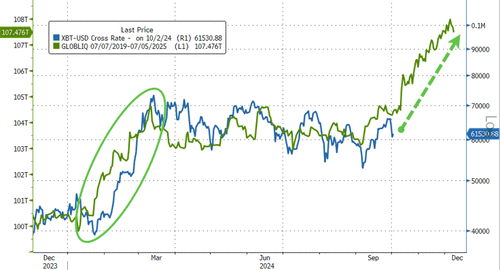Unsurprisingly, The Bitcoin Price Follows Global Liquidity
Authored by Vivek Sun via BitcoinMagazine.com,
I have been intrigued by the significant increase in global liquidity during 2024, driven by extensive money printing and debt expansion, and how it impacts Bitcoin’s price.
Bitcoin is an expression against the government’s monetary expansionist policies, so its price follows global liquidity, as seen here on this chart.
It was fascinating to read the recent report by Lyn Alden and Sam Callahan analyzing Bitcoin’s correlation to global liquidity.
This further reconfirmed my view that more monetary expansion drives more people to Bitcoin, increasing prices.
Their rigorous analysis found that over 12-month periods, Bitcoin’s price moves in the same direction as global liquidity a remarkable 83% of the time.
This is higher than any other major asset class, making Bitcoin a uniquely pure barometer for global liquidity trends.
The report quantified Bitcoin’s correlation with global M2 money supply, finding a very strong 0.94 overall correlation between May 2013 and July 2024. Bitcoin’s average 12-month rolling correlation was 0.51, while stocks and gold showed moderately high correlations as well in the 0.4 to 0.7 range.
Of course, Bitcoin’s correlation isn’t perfect. Shorter-term breakdowns can occur around crypto-specific events like exchange hacks or Ponzi schemes collapsing.
Supply-demand imbalances also cause temporary decoupling when Bitcoin reaches extreme overvaluation levels during market cycle peaks.
Yet despite these breakdowns, the long-term relationship persists.
Right now, liquidity is soaring to unprecedented levels, suggesting Bitcoin could soon embark on a massive bull run if this relationship holds.
While I believe no model perfectly captures Bitcoin’s complexity, recognizing its role as a monetary canary in the coal mine can lend valuable insight.
If history rhymes, Bitcoin’s sirens are ringing loudly that a liquidity-driven boom will soon be underway.
Tyler Durden
Wed, 10/02/2024 – 17:00




Share This Article
Choose Your Platform: Facebook Twitter Linkedin